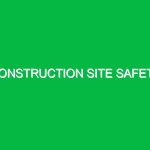Demolition operations are an essential part of construction and urban development. However, they come with significant risks that can impact workers, the surrounding community, and the environment. Safety in demolition operations isn’t just a regulatory requirement; it’s a fundamental necessity that protects lives and resources. In this article, we’ll explore the various hazards associated with demolition, discuss best practices for safety, and highlight the regulations that govern these operations.
The Relevance of Safety in Demolition Operations in HSE
Health, Safety, and Environment (HSE) practices are critical in maintaining a safe workplace, particularly in demolition tasks, where the nature of work involves risks such as structural collapse, exposure to hazardous materials, and accidents involving heavy machinery. The importance of safety in demolition operations cannot be overstated; it serves as a cornerstone for ensuring the well-being of workers, minimizing environmental impact, and fostering a culture of safety in the industry.
In my years working in construction management, I’ve witnessed firsthand the ramifications of neglecting safety protocols. A colleague once recounted an incident where a lack of proper safeguards led to a serious injury when a wall unexpectedly collapsed during an active demolition. This incident served as a sobering reminder that safety is not just a checklist; it is a continuous commitment to vigilance and care.
Identifying Hazards and Risks in Demolition Operations
Understanding potential hazards is the first step toward establishing effective safety protocols. Demolition operations present various risks, including:
1. Structural Hazards
One of the most significant risks in demolition is the potential for structural collapse. Buildings can be unpredictable, and without proper assessments, workers can be exposed to life-threatening situations. It’s vital to conduct thorough structural evaluations before any demolition work begins.
2. Hazardous Materials
Many older buildings may contain hazardous materials such as asbestos, lead, or polychlorinated biphenyls (PCBs). Exposure to these substances can lead to severe health issues, including respiratory diseases and cancers. Identifying and managing these materials before demolition is critical.
3. Equipment and Machinery Risks
Heavy machinery such as excavators, bulldozers, and wrecking balls are often used in demolition. These machines pose risks of accidents and injuries, especially if operators are not properly trained or if equipment is not maintained. Ensuring that all operators are certified and that machinery undergoes regular inspections is vital.
4. Falling Debris
Demolition sites are often plagued by falling debris, which can injure workers or bystanders. Establishing exclusion zones and using protective gear can significantly reduce this risk.
5. Noise and Vibration
The noise generated by demolition activities can lead to hearing loss over time, while vibrations can affect nearby structures and cause discomfort to workers. Implementing noise control measures and monitoring vibration levels can help mitigate these risks.
6. Environmental Risks
Demolition can have significant environmental impacts, including dust, debris, and potential contamination of surrounding areas. Proper management of waste materials and adherence to environmental regulations are crucial to minimize these impacts.
Safety Precautions and Best Practices for Demolition Operations
Once hazards are identified, it is essential to implement safety precautions and best practices to mitigate risks. Here are several actionable strategies:
1. Comprehensive Risk Assessment
Before any demolition begins, conduct a detailed risk assessment. This should include identifying hazards, evaluating their potential impact, and determining the necessary safety measures to mitigate those risks.
2. Training and Certification
Ensure that all personnel involved in demolition operations are adequately trained and certified. Training should cover equipment operation, emergency response, and the handling of hazardous materials. Regular refreshers can help maintain a high level of safety awareness.
3. Use of Personal Protective Equipment (PPE)
PPE is a frontline defense against many hazards. Workers should be equipped with hard hats, safety goggles, gloves, and high-visibility clothing, as well as respiratory protection when dealing with hazardous materials. Regularly inspect and replace PPE as necessary to ensure its effectiveness.
4. Establish Safe Work Zones
Implement strict access controls to demolition sites. Use barriers and signage to limit entry to authorized personnel only. Establishing exclusion zones around demolition operations can protect bystanders and reduce the risk of accidents.
5. Safety Protocols for Equipment Use
All machinery should be operated according to the manufacturer’s specifications. Regular inspections and maintenance are key to preventing equipment-related accidents. Operators should perform daily checks on machinery before use to ensure safe operation.
6. Environmental Management Plans
Developing an environmental management plan is essential for mitigating the environmental impacts of demolition. This includes procedures for handling waste, controlling dust, and managing noise levels. Ensure compliance with local environmental regulations to minimize risks to the community.
7. Emergency Preparedness
Every demolition site should have an emergency response plan in place. This plan should outline procedures for various emergency scenarios, including structural collapses, fires, and exposure to hazardous materials. Conduct regular drills to ensure all personnel are familiar with the procedures.
Regulations and Standards Governing Safety in Demolition Operations
In the realm of demolition, several regulations and standards govern safety practices, ensuring that operations are conducted in a manner that minimizes risks. Key regulations include:
1. OSHA Standards
The Occupational Safety and Health Administration (OSHA) sets forth specific standards for demolition operations outlined in 29 CFR 1926. These regulations cover various aspects, including hazard communication, fall protection, and the handling of hazardous materials.
2. EPA Regulations
The Environmental Protection Agency (EPA) regulates the management of hazardous waste, ensuring that hazardous materials are disposed of correctly during demolition. Compliance with EPA regulations is crucial for minimizing environmental impacts.
3. Local Building Codes
Local building codes often include specific requirements for demolition, including permit processes and safety measures. It’s essential to familiarize yourself with these codes to ensure compliance and safety throughout the demolition process.
Conclusion: The Continuous Commitment to Safety in Demolition Operations
Safety in demolition operations is a multifaceted issue that requires ongoing attention, training, and adaptation. The hazards are significant, but they can be effectively managed with the right practices and a commitment to safety. By understanding the risks, implementing best practices, and adhering to regulations, we can protect workers, the community, and the environment from the dangers associated with demolition. As someone who has seen both the successes and failures of safety practices, I can confidently say that a proactive approach is the best way forward. In a field where the stakes are high, the commitment to safety must be unwavering.


